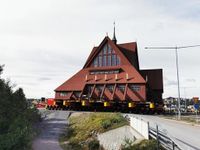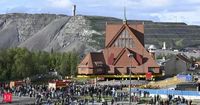In a remarkable blend of engineering prowess, cultural preservation, and community spirit, the historic Kiruna Church in northern Sweden has completed a two-day, five-kilometer relocation to a safer site, captivating thousands and drawing attention from around the world. The move, which took place on August 19 and 20, 2025, stands as a testament to the town’s resilience as it faces the challenges posed by ongoing iron ore mining beneath its foundations.
The church, a 113-year-old wooden landmark renowned for its vivid red cladding and unique architectural mix of Scandinavian and indigenous Sámi styles, has long served as a symbol of Kiruna’s identity. According to The Economic Times, the church is widely recognized as one of the nation’s finest wooden buildings, and its relocation marks not just a logistical feat but the continuation of a cherished legacy.
Kiruna, situated about 145 kilometers north of the Arctic Circle in Sweden’s Lapland region, sits atop one of the world’s richest iron ore deposits. Mining has been a central part of the town’s existence since the 1890s, but it’s also the root cause of the subsidence—the gradual sinking of the ground—that forced the church’s move. LKAB, Europe’s largest iron ore producer and the state-owned company behind the mine, warned as early as 2004 that the city would need to be relocated if mining was to continue. The ore body extends beneath the urban area, and as more is extracted, cracks and instability threaten buildings and infrastructure.
The church’s journey began with a heartfelt ceremony led by parish vicar Lena Tjärnberg and Bishop Åsa Nyström of the Diocese of Luleå. As reported by CNA Newsroom, Tjärnberg acknowledged the bittersweet necessity of the move, stating, “The church is leaving from a place where it truly belongs. Everyone understands that it must be moved: We live in a mining community that depends on the mine.” The blessing set the tone for what quickly became a public spectacle and a celebration of heritage.
Transporting the church was no small task. The massive structure, weighing approximately 1,200 tonnes (about 672 tonnes for the church alone, plus the transport platform), was mounted on a specially designed trolley with 224 wheels. The convoy crawled along at a painstakingly slow pace—about 500 meters per hour, or 1,600 feet per hour—requiring roads to be widened to 24 meters (79 feet) and a viaduct demolished to accommodate the building’s 131-foot width. Signs and lampposts along the route had to be removed to allow passage, as detailed by the BBC and High North News.
The meticulous planning for the move spanned eight years and cost an estimated 500 million Swedish kronor (around $52 million). The operation involved clearing out most of the church’s inventory, though the altarpiece and other cultural treasures—including the large organ with over 2,000 pipes and Prince Eugen’s Art Nouveau painting “The Holy Grove”—remained inside and were specially protected throughout the journey, according to CNA Newsroom.
As the church inched along its new route, an estimated 10,000 spectators—more than half of Kiruna’s 18,000 residents—lined the streets, waving flags, filming, and celebrating what many called a once-in-a-lifetime event. The spectacle was broadcast live on Swedish television as “slow TV,” drawing even more attention and turning the move into a national event. Festivities along the route included live entertainment, snacks, and refreshments, transforming the relocation into a true celebration of Swedish heritage and community spirit, as reported by Kiruna Tourism and BBC.
King Carl XVI Gustaf was expected to attend and participate in ceremonial events during the move, highlighting the national significance of the occasion. The move also drew international coverage, with media outlets from around the world reporting on the extraordinary feat of relocating such a large and historic building intact.
The church itself, designed by Swedish architect Gustaf Wickman between 1909 and 1912 as a gift from LKAB to the local congregation, was voted Sweden’s most beautiful building constructed before 1950 in a 2001 national poll. Its design draws inspiration from both Norwegian stave churches and Sámi lavvos (traditional tents), and its interior features Art Nouveau altarpieces and Sámi-inspired pews, reflecting the region’s cultural fusion. According to High North News, the church stands 40 meters tall and has long been a community hub as well as a place of worship.
The relocation of the church is just one part of a much larger urban transformation project in Kiruna. As the LKAB mine continues to expand, the entire town center is being moved to safer ground. This broader effort, underway since 2014, has already seen the completion of new homes, businesses, schools, and public infrastructure. Ultimately, about a third of Kiruna’s residents—roughly 6,000 people—are being resettled, and the city’s appearance is rapidly changing from a traditional mining town to what some describe as a “miniature Manhattan.”
Yet not everyone has welcomed the changes uncritically. The relocation has sparked protest from parts of Sweden’s Sámi community, who say that the mining expansion and urban transformation have disrupted traditional reindeer herding territories. According to SVT, Sweden’s national broadcaster, these concerns highlight the complex balance between industrial development, cultural preservation, and indigenous rights.
Despite the challenges, the church’s safe arrival on firmer ground was met with cheers and applause. The structure will undergo restoration at its new site near Kiruna’s cemetery and new city center, with plans to reopen to visitors at the end of 2026. The bell tower, which was moved separately, will soon be reunited with the main building, ensuring that the church’s silhouette remains a defining feature of Kiruna’s skyline.
The relocation of Kiruna Church stands as a powerful example of how tradition and modernization can coexist—even as the ground literally shifts beneath a community’s feet. The event has not only preserved a beloved landmark but also provided a unique boost to local tourism, drawing visitors eager to witness the intersection of engineering ingenuity and cultural heritage. As Kiruna continues to evolve, the church’s journey will remain a defining chapter in the town’s remarkable story.



